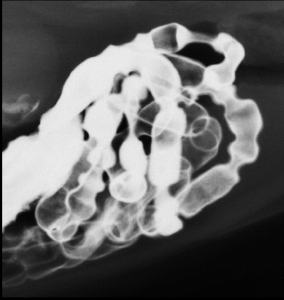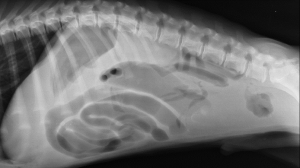28 General motility diagnostics
Diagnosis of motility disorders
Transit times vary by species and by area of the gut

In veterinary medicine, we commonly listen for gut sounds. However, this is a very nonspecific and insensitive test. Contrast radiographs, contrast fluoroscopy and ultrasound are the most commonly used tools for more accurate diagnoses.
Contrast radiographs provide a snapshot at one point in that can at least suggest activity or show distension.


Ultrasound can show activity; however, activity doesn’t always mean motility (uncoordinated activity can lead to poor motility)
Intestinal ultrasound – types of activity
Intestinal ultrasound equine
Colon scan canine (scan starts at 1:20)
Emptying studies are more accurate than ultrasound but are more involved.
Stomach activity (human) – barium study
What is a fluoroscopy (human)
Indigestible markers can be used to evaluate total transit time. In horses, mineral oil is used as a tool, with passage expected in 12-24 hours. For more detailed evaluation, plastic beads or radioactive markers are used.
Abnormal motility disorders
Lack of motility or activity in ultrasound and contrast studies is generally abnormal.
Reverse flow of ingesta in the esophagus, stomach and SI is abnormal in non-ruminants.
Changes in stool (softer, dryer, different shape or color) are major clues to changes in the GI tract.

